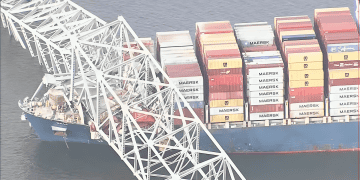In a harrowing event early Tuesday morning, a significant infrastructure failure occurred as the Baltimore Key Bridge, an essential traffic conduit in Maryland, suffered a catastrophic collapse. The incident unfolded when a container vessel, flagged under Singapore and en-route to Colombo, Sri Lanka, struck the bridge, leading to substantial structural failure and the subsequent plunge of multiple vehicles and construction personnel into the waters below.
According to statements from the Baltimore Fire Department, the sudden and unexpected collapse triggered an immediate search and rescue operation, with at least six construction workers, engaged in maintenance activities on the bridge at the time, reported missing. Senior officials from Brawner Builders, the contracting firm employing the missing workers, have expressed grave concerns for their safety, considering the elapsed time and challenging conditions at the site.
The incident drew a swift reaction from national leadership, with President Joe Biden addressing the nation, characterizing the event as a “terrible accident” and extending federal support to local authorities and affected families. The President affirmed the nation’s solidarity with the Baltimore community and pledged ongoing assistance in the recovery efforts.
Local and federal agencies were quick to respond, with emergency protocols activated to manage the crisis. The container ship involved, identified as the Dali, experienced a loss of power leading up to the collision, complicating an already dire situation. The bridge’s strategic importance to the region’s transportation network underscores the extensive impact of this disaster, with significant disruptions anticipated in the coming months.
This incident raises pressing questions about infrastructure safety, emergency response readiness, and the broader implications for supply chain continuity. As investigations proceed, stakeholders from across the supply chain spectrum, from logistics professionals to policymakers, are closely monitoring developments. The resilience of supply chain networks, particularly in handling unexpected disruptions, remains a critical focus area.
In the aftermath of the Baltimore Key Bridge collapse, discussions have intensified around infrastructure integrity and the broader ramifications for global supply chains and trade dynamics. The bridge, a vital artery for the regional transportation network and a key link for the Port of Baltimore, is now at the center of a comprehensive investigation to understand the sequence of events leading to the tragedy and to develop strategies to prevent future incidents.
The loss of life and potential environmental damage from the collapse brings to light the human and ecological costs of such infrastructure failures. The bridge’s destruction not only poses immediate logistical challenges but also prompts a reevaluation of safety protocols and maintenance practices for aging infrastructure critical to commerce and daily life.
The international community has taken note, with the Maritime and Port Authority of Singapore, the flag state of the vessel involved, coordinating with the U.S. Coast Guard and the ship’s management company to aid in the investigation. The incident has also sparked a conversation about the resilience of supply chains, particularly in the face of unforeseen disasters.
As the recovery effort continues, the impact on local communities, businesses, and the broader supply chain ecosystem is becoming increasingly apparent. Traffic reroutes and delays are expected to have a ripple effect on supply chain operations, underscoring the interconnected nature of global trade and the need for robust risk management strategies.
As the investigation into the Baltimore Key Bridge collapse progresses, stakeholders across various sectors are beginning to assess the long-term implications of the disaster. The incident not only disrupts local and national transportation networks but also has potential international trade ramifications, given the bridge’s role in facilitating access to one of the East Coast’s key ports.
The focus has now shifted towards understanding the underlying causes of the collapse and implementing measures to prevent similar incidents. This includes a thorough examination of the bridge’s design, maintenance records, and the sequence of events leading up to the accident. Additionally, the response to the incident will likely inform future policies and technologies aimed at enhancing infrastructure resilience and emergency preparedness.
The global trade community is particularly attentive to the outcomes of the investigation, as it could lead to revised standards and practices in maritime operations and infrastructure management. The incident underscores the need for continuous investment in infrastructure and innovation in supply chain management to adapt to the complexities of global trade.
Furthermore, the tragedy highlights the importance of community and government response to crises, demonstrating the need for effective communication and coordination among all parties involved. The solidarity and support from the Baltimore community and the nation reflect the resilience and collective strength in the face of adversity.
As The Supply Chain Report continues to monitor this situation, we aim to provide our readers with comprehensive coverage that not only reports on the incident but also delves into the lessons learned and the path forward for the supply chain and logistics industry. The Baltimore Key Bridge collapse is a pivotal moment that will undoubtedly shape future discussions on infrastructure sustainability, safety, and innovation.
Stay current with supply chain report news at The Supply Chain Report. For international trade tools, see ADAMftd.com.
#TheSupplyChainReport #InfrastructureResilience #MaritimeOperations #FutureOfTrade #CommunityResponse #InnovationInLogistics #SafetyStandards #GlobalTradeInsights #LogisticsIndustryUpdate

















